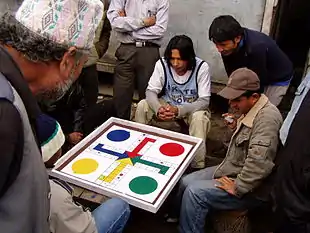Ludo (board game)
Ludo (/ˈljuːdoʊ/; from Latin ludo 'I play') is a strategy board game for two to four[lower-alpha 1] players, in which the players race their four tokens from start to finish according to the rolls of a single die. Like other cross and circle games, Ludo is derived from the Indian game Pachisi, but simpler. The game and its variations are popular in many countries and under various names.
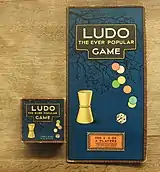 One of the first editions of Ludo | |
| Years active | Since c. 1896 |
|---|---|
| Genre(s) | Board game Race game Dice game |
| Players | 2–4 |
| Playing time | < 90 min |
| Random chance | High (dice rolling) |
| Age range | 3+ |
| Skill(s) required | Strategy, tactics, counting, probability |
History
Pachisi was created in India in the 6th century. The earliest evidence of this game's evolution in India is the depiction of boards on the caves of Ellora. The original version is also described in Indian epic Mahabharata in which Shakuni uses the cursed dice to beat the Pandavas and at last after losing everything, Yudhisthira puts his wife Draupadi on stake and loses her too. However, Pandavas get all their belongings back after Draupadi vows to curse the whole Kuru lineage but stops at the intervention of Gandhari and seeing an opportunity to vent Draupadi's anger, Kuru king Dhritarashtra promises to give back the Pandavas, all that they had lost in the game. It was also known as Chaupar in ancient times. The contemporary version was played by the Mughal emperors of India; a notable example is Akbar.[1]
Pachisi was modified to use a cubic die with dice cup and patented as "Ludo" in England in 1896.[lower-alpha 2][2][3] The Royal Navy took Ludo and converted it into the board game Uckers.[4]
Ludo board

Special areas of the Ludo board are typically coloured bright yellow, green, red, and blue. Each player is assigned a colour and has four tokens[lower-alpha 3] in their colour. The board is normally square with a cross-shaped playspace, with each arm of the cross having three columns of squares, usually six per column. The middle columns usually have five squares coloured; these represent a player's home column. A sixth coloured square not on the home column is a player's starting square. At the centre of the board is a large finishing square, often composed of coloured triangles atop the players' home columns (thus depicting "arrows" pointing to the finish).
Rules
Overview
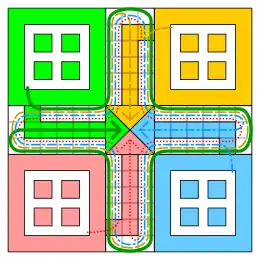
Two, three, or four can play, without partnerships.[lower-alpha 4] At the beginning of the game, each player's four tokens are out of play and staged in the player's yard (one of the large corner areas of the board in the player's colour). When able to, the players will enter their tokens one per turn on their respective starting squares, and proceed to race them clockwise around the board along the game track (the path of squares not part of any player's home column). When reaching the square below his home column, a player continues by moving tokens up the column to the finishing square. The rolls of a single die[6][7] control the swiftness of the tokens, and entry to the finishing square requires a precise roll from the player. The first to bring all their tokens to the finish wins the game. The others often continue to play to determine second-, third-, and fourth-place finishers.
Gameplay
Each player rolls the die; the highest roller begins the game. Players alternate turns in a clockwise direction.
To enter a token into play from its yard to its starting square, a player must roll a 6.[6][7] The player can draw a token from home every time he gets a 6 unless home is empty or move a piece 6 times. The start box has 2 own tokens (is doubled). If the player has no tokens yet in play and rolls other than a 6, the turn passes to the next player.
Players must always move a token according to the die value rolled. Once a player has one or more tokens in play, he selects a token and moves it forwards along the track the number of squares indicated by the die. If an opponent's token is blocking your pathway, you will need to land on the same space as the token to capture it. You cannot move past that token. Passes are not allowed; if no move is possible, the turn moves to the next player.
If the player cannot draw a token from home, rolling a 6 earns the player an additional or "bonus" roll in that turn. If the bonus roll results in a 6 again, the player earns again an additional bonus roll.[lower-alpha 5] If the third roll is also a 6, the player may not move and the turn immediately passes to the next player.
If the advance of a token ends on a square occupied by an opponent's token, the opponent token is returned to its owner's yard. The returned token can be reentered into play only when the owner rolls a 6. If a piece lands on the same space as another piece of the same colour, the pieces are doubled and form a "block".[5] If the advance of a block ends on an opponent’s block, the latter is captured and returned to its owner’s yard, collectively.[8][9]
A player's home column squares are always safe since no opponent may enter them. In the home column, you cannot jump over your token. Roll the exact number needed to get each token onto the home triangle.
Variants
list of international variants
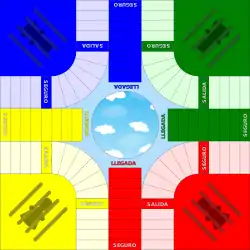
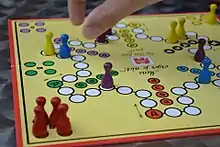
Ludo exists under different names, brands and various game derivations:[10]
Spanish & Colombian
- Parchís, Spanish
- Parqués, Colombian
- Vuelta obligada (mandatory restart)
- Cielo robado (stolen heaven)
- De piedra en piedra (from stone to stone)
- Con Policía (With Policeman)
Mensch ärgere dich nicht
Mensch ärgere dich nicht (Mate, Don't Get Angry), is a German game from 1914 and has equivalent names in Bulgarian, Croatian, Slovenian, Serbian, Macedonian, Albanian, Greek, Romanian, Polish, Turkish, Czech, and Slovak.
- Mens Erger Je Niet, Dutch
- Non t'arrabiare, Italian
German specific
- Verliere nicht den Kopf (Do not lose your head)
- Coppit
French
- Petits Chevaux (Little Cavalry)
- Jeu des petits chevaux
Hasbro
.jpg.webp)
Hasbro has multiple brand names for ludo-like games from its acquisitions including:
Differences
- Ludo played in the Indian subcontinent features a safe square in each quadrant, normally the fourth square from the top in the rightmost column. These squares are usually marked with a star. In India Ludo is often played with two dice, and rolling 1 on a die also allows a token to enter active play. Thus if a player rolls a 1 and a 6, they may get a token out and move it six steps.
- In Pakistan, a variation that uses two dice allows backwards movement. The dice are rolled and the die values can be used independently or in combination to move two pieces or a single piece forwards or backwards or both. (E.g., if the roll gives 1 and 4, the player can move a single piece 4 steps forwards and then 1 step backwards, or 1 step forwards and 4 steps backwards, or 1 then 4 steps forwards or backwards. Or the player can move a piece 1 step forwards or backwards, and another piece 4 steps forwards or backwards.)
- To get a game started faster, some house rules allow a player with no pieces on the board to bring their first piece into play on any roll, on a 1 or a 6, or allow multiple tries to roll a 6 (with three rolls being the most popular).
- If a piece lands on the same space as another piece of the same colour, the moved piece must take the preceding space.
- Some variations permit doubled blocks to be passed by rolling a 6 or 1.
- A block of two or more pieces can be taken by an opponent's single piece.[18]
- Doubled pieces may move half the number if an even number is thrown (e.g. move two spaces if a 4 is thrown).
- A doubled piece may capture another doubled piece (like in Coppit). Three pieces together are weak and can be cut by a single piece.
- A board may have only four spaces in each home column. All four of a player's pieces must finish in these spaces for the player to have finished the game. (See Mensch ärgere dich nicht.)
- A player must move all the numbers rolled (e.g. if a player rolls multiple 6s, they have to use all the numbers to move).
- A player cannot capture or enter finish if they have numbers remaining. (E.g., if a player rolls a 6 and a 2 and they have the option to capture or enter finish with one of their pieces using the 2, they can only do so if they have another piece that can use the 6.)
- To speed the game up, extra turns or bonus moves can be awarded for capturing a piece or getting a piece home; these may grant passage past a block.
- In Denmark and some other countries the board has eight spaces marked with a globe and eight with a star. The globes are safe spaces where a piece cannot be captured. The exception is that a player who has not yet entered all pieces, can always enter a piece on a roll of 6. If the entry space is occupied by another player's piece, that piece is captured. Otherwise the entry spaces work like the other globe spaces. A piece which would have landed on a star instead moves to the next star.
- In Vietnam, it is called "Cờ cá ngựa", where the game is modeled after a horse race with the tokens modeled as horse heads. In this variation, a 1 is given equal status to a 6 (meaning that the player can enter a token into play and can roll again). Furthermore, once a player's token reaches their home column, it can only go up each square with an exact roll. This means that a person outside the column must roll a 1 to enter the first square, a 2 afterwards to enter the second, and so forth.

African
In some parts of Africa the following rules are reportedly played:
- A doubled block also blocks trailing pieces of the player who created the block, or blocks them unless they roll the exact number to land on the block; additionally, the doubled block cannot move forwards until the block that landed upon it moves off again. This reduces the tactical advantage of a block and makes the game more interesting.
- If the two players sitting opposite are partners, the players can exchange numbers.
- There are four safety squares on the board, like castle squares in Pachisi, as well as the safe home squares, where a piece may able to move forwards or backwards and start their turn before previous player finishes.
- A piece landing on a square with an opponent's piece not only sends the opponent piece back to the starting area but also sends the landing piece to its home square.
- A player cannot move their first piece into the home column unless they have captured at least one piece of any of the opponents.
- If a player captures the piece of another player, they are awarded a bonus roll. If in the bonus roll, another player's piece is captured, another bonus roll is awarded and so on.
Notes
- In some countries (at least Denmark) a variant for six players is available, but it is uncommon.
- Patent number 14636.[2]
- Tokens were originally flat bone discs;[5] modern materials are cardboard or plastic.
- "From two to four-play, each with four pieces, and without partnerships."[6]
- "Should a player throw two 6s in succession, he is allowed a third throw."[7]
![]() This article incorporates text from a publication now in the public domain: Chisholm, Hugh, ed. (1911). "Petits-Chevaux". Encyclopædia Britannica. 21 (11th ed.). Cambridge University Press. p. 308.
This article incorporates text from a publication now in the public domain: Chisholm, Hugh, ed. (1911). "Petits-Chevaux". Encyclopædia Britannica. 21 (11th ed.). Cambridge University Press. p. 308.
References
- Grunfeld (1975), p. 27
- Bell, R. C. (1979) [1st Pub. 1960, Oxford University Press, London]. Board and Table Games From Many Civilizations. I (Revised ed.). Dover Publications Inc. p. 12. ISBN 0-671-06030-9.
- "Pachisi & Ludo – pc games, rules & history". vegard2.net.
- Padfield, Peter (1995). War Beneath The Sea. New York, NY: John Wiley & Sons, Inc. p. 86. ISBN 0-471-24945-9.
- Bell (1983), p. 113.
- Parlett (1999), p. 49.
- Diagram Group (1975), p. 13.
- "Funkill Ludo". funkill.live.
- "Ludo Official BSE Rules" (PDF). Banglagym.com.
- "Archived copy". Archived from the original on 2012-07-12. Retrieved 2009-02-03.CS1 maint: archived copy as title (link)
- "Personal Time - Uckers". Retrieved 2011-09-17.
- "Aggravation Rules" (PDF). Fgbradleys.com. Retrieved 12 November 2017.
- https://boardgamegeek.com/boardgame/9921/headache
- Office, Government of Canada, Industry Canada, Office of the Deputy Minister, Canadian Intellectual Property. "Canadian Patent Database / Base de données sur les brevets canadiens". brevets-patents.ic.gc.ca. Archived from the original on 27 July 2011. Retrieved 30 December 2009.
- "Search for a trade mark – Intellectual Property Office". www.ipo.gov.uk. Archived from the original on 1 April 2012. Retrieved 30 December 2009.
- "History". Archived from the original on 4 November 2008. Retrieved 30 December 2009.
- https://www.ultraboardgames.com/trouble/game-rules.php
- Murray (1978), p. 138.
Bibliography
- Bell, R. C. (1983). The Boardgame Book. Exeter Books. ISBN 0-671-06030-9.
- Diagram Group (1975). Ruth Midgley (ed.). The Way to Play. Paddington Press Ltd. pp. 12–13. ISBN 0-8467-0060-3.
- Grunfeld, Frederic V., ed. (1975). Games of the World. Holt, Rinehart and Winston. ISBN 0-03-015261-5.
- Murray, H. J. R. (1978). A History of Board-Games other than Chess (Reissued ed.). Hacker Art Books Inc. ISBN 0-87817-211-4.
- Parlett, David (1999). The Oxford History of Board Games. Oxford University Press Inc. ISBN 0-19-212998-8.
External links
| Wikimedia Commons has media related to Ludo. |
- Pachisi (Ludo etc.) The Online Guide to Traditional Games
